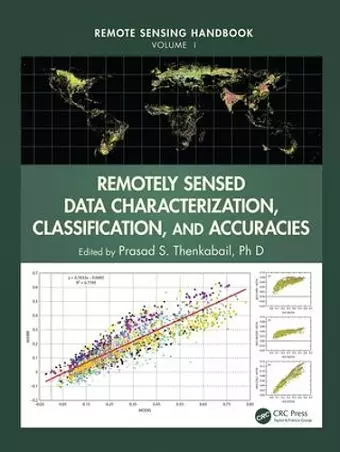Remotely Sensed Data Characterization, Classification, and Accuracies
Format:Hardback
Publisher:Taylor & Francis Inc
Published:2nd Oct '15
Currently unavailable, and unfortunately no date known when it will be back

A volume in the Remote Sensing Handbook series, Remotely Sensed Data Characterization, Classification, and Accuracies documents the scientific and methodological advances that have taken place during the last 50 years. The other two volumes in the series are Land Resources Monitoring, Modeling, and Mapping with Remote Sensing, and Remote Sensing of Water Resources, Disasters, and Urban Studies.
This volume demonstrates the experience, utility, methods, and models used in studying a wide array of remotely sensed data characterization, classification, and accuracies for terrestrial applications. Leading experts on global geographic coverage, study areas, and array of satellite and sensors contribute to this unique handbook. This theoretical as well as highly practical book represents a thorough history of advancement in the field over last 50 years, bringing us to where we are now, and highlighting future possibilities.
Highlights include:
- Fundamental and advanced topics in remote-sensing satellites and sensors
- Remote sensing data calibration, normalization, harmonization, and synthesis
- Optical, Radar, LiDAR, thermal, hyperspectral, and other satellite sensors, normalization of remotely sensed data, and data degradations
- Digital image processing, urban image classification, and image classification methods in land use\land cover, cropland, change detection studies
- Enhanced vegetation indices and standardization of vegetation indices
- Object-based image analysis (OBIA) and geospatial data integration
- LiDAR data processing and applications
- Geoprocessing, GIS, and GIScience
- GNSS applications
- Crowdsourcing and cloud computing
- Google Earth for Earth Sciences
- Map accuracies
- Remote-sensing law or space law, and a host of other topics
Considered magnum opus on the subject, the three-volumeRemote Sensing Handbook is edited by Dr. Prasad S. Thenkabail of the United States Geological Survey and a renowned international expert in remote sensing and GIScience, with contributions from the very best leading global experts, the handbook gives you a knowledge base on the evolution of remote sensing science, current state-of-the-art technology, and a future vision for the field.
Here Is What Top Global Remote Sensing Experts Say about the Remote Sensing Handbook, Three-Volume Set
1. Remotely Sensed Data Characterization, Classification, and Accuracies
2. Land Resources Monitoring, Modeling, and Mapping with Remote Sensing
3. Remote Sensing of Water Resources, Disasters, and Urban Studies
"I have had the pleasure and honor to be involved in the field of remote sensing for nearly 50 years. To say that much has changed and been accomplished in this field over this time period is a severe understatement. It would require literally hundreds of experts on a global basis to characterize the history, scope, utility, dynamism, and future outlook for remote sensing. It is this exact feat that is accomplished through the contributions of over 300 highly respected, international researchers and practitioners in the production of Remote Sensing Handbook (three volumes). This comprehensive treatise sets a new standard for spanning and integrating discussion of remote sensing principles, data, methods, development, applications, and scientific and social context. It will be an invaluable multidisciplinary reference for many years to come."
— Dr. Thomas M. Lillesand, Emeritus Professor of Remote Sensing, University of Wisconsin-Madison, USA, and chief author of the most widely read Remote Sensing and Image Interpretation
"It is a great pleasure to be asked to endorse this comprehensive new book. It is a truly ambitious task to bring together so much information about remote sensing and the range of the material covered is impressive. It puts one in mind of the Manual of Remote Sensing, first edition 1975, second edition 1983. While much of the basic information in that earlier book is still valid, things have moved on and there was clearly scope for a new approach. In those early days, the systems flown in space were the early Landsat sat
ISBN: 9781482217865
Dimensions: unknown
Weight: 2100g
678 pages